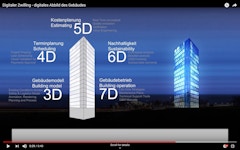
130 results
-

-

Call for Peer Reviewers: Help Shape the 2026 FTI World Congress
- Announcement
We invite FTI Members, past Peer Reviewers, and Friends of FTI to serve as peer reviewers for the 2026 World Congress. Your expertise is essential in ensuring that the research presented maintains the highest standards of quality, relevance, and rigor.
-

Call for Posters: Facade Tectonics 2020 World Congress
- Announcement
We are pleased to announce that for the first time, the Facade Tectonics Institute will include a poster presentation at their 2020 World Congress. The poster presentation will serve as a graphic representation of each poster author's research and findings.
-

Lithic Revival
- Paper by Alex Terzich,
The recently completed Capital One Hall performing arts center located in the Washington DC metro area is defined by a pleated exterior of glass and… -

All-Glass Bearing Facades
- Paper by Erwin ten Brincke, MSc
The Green Village at the TU Delft is a living lab for sustainable innovations. The Co Creation Centre (CCC) will be their new meeting center (13.5 x… -

HydroSKIN
- Paper by Christina Eisenbarth, M.Sc., Research Associate Walter Haase, Dr.-Ing., Managing Director of CRC1244, Head of Working Groups Lucio Blandini, Prof. Dr.-Ing. M.Arch., Professor and Head of the Institute Werner Sobek, Prof. Dr.-Ing. Dr.-Ing. E.h. Dr. h.c., Senior Professor
Building envelopes cover a considerable part of the urban exterior surfaces, and to therefore have a significant leverage effect on the climate… -

Exo-Skins
- Paper by Nick Braaksma, Malini Srivastava, AIA, Chad Ulven,
Cost-effective, sustainable, self-actuating, thermally-responsive, bio-composite exo-skins that act like shields or cloaks for existing buildings… -
OpenFacadeControl
- Paper by Peter Grant · Tzu-Ching Su · Luis Fernandes · Jordan Shackelford · Anand Prakash · Stephen Czarnecki · Pei-Yu Yu · Feng-Yi Lin
Automated facades are, for the most part, still considered as separate from other building systems throughout the design, installation,
-

Glazed Spandrels
- Paper by Julien Schwartz, M.Eng., Patrick Roppel, M.A.Sc, P.Eng., Stéphane Hoffman, M.Eng, M.Arch, P.Eng, P.E., Neil Norris, M.A.Sc, P.Eng, C.P.H.D.,
Recent years have seen an increased use of insulated glazing units in spandrel applications to visually blend the appearance between the vision and… -
Design and Energy Analysis
- Paper by Mahsa Farid Mohajer · Ajla Aksamija
Integration and interoperability between Building Information Modeling (BIM) and Building Energy Modeling (BEM) tools pose major challenges for the
-

Call for Abstracts: Facade Tectonics 2024 World Congress
- Announcement
The Facade Tectonics Institute (FTI) announces a call for abstracts for our 2024 World Congress (2024WC) to be convened in Southern California on October 8-10. When it comes to the building facade there is much to talk about.
-

ANFA 2021 Call for Presenters
- Event by Academy of Neuroscience for Architecture
The ANFA Conference will explore, from a scientific basis, the range of human experiences that occur in context with elements of architecture, both exterior and interior. Abstracts will be accepted until February 28, 2021.
-

Digital Lifecycle of Building Envelopes
“The digital transformation will change everything” – with this quote in mind a deep look into the current facade business will be given with a
-

European Facade Networks
- Paper by Ulrich Knaack · Uta Pottgiesser · Tillmann Klein · Andreas Luible · Siebe Bakker
The European climate and energy targets for 2020 demand significant improvement of the energy performance of buildings since one third of the
-

Call for Abstracts: Facade Tectonics 2022 World Congress
- Announcement
The Facade Tectonics Institute (FTI) announces a call for abstracts for our 2022 World Congress (2022WC) to be convened in Los Angeles on October 12-13. When it comes to the building facade there is much to talk about. And the Institute is aggressively inclusive, with the mission of bringing all...
-

Event Passed
APT Seattle Conference Symposium 2023: Aging Composite Materials and Assemblies
- Seattle, United States
Aging modern heritage buildings and structures face complex repair and reinvestment challenges. Manufactured composite materials and multi-material assemblies often cannot be cost-effectively repaired or replaced in kind.
Industry Event by Association for Preservation Technology
-

Establishing a Life Cycle Assessment Methodology for Innovative Facade
- Paper by Vikki Lew,
Life cycle assessment was introduced in the 1970s as an analytical tool to quantify the environmental impact of a product, process, or service.… -

Thermoelectric Facades
- Paper by Ajla Aksamija, PhD, LEED AP BD+C, CDT · Zlatan Aksamija, PhD · Mahsa Farid Mohajer · Meenakshi Upadhyaya · Guy Vigneau
This article discusses design, prototype development and a simulation study of novel types of facade systems, which integrate thermoelectric (TE)
-

-
Integrated Building Control System
- Paper by Jae Yong Suk, Ph.D. · Keith Graeber, PE · Andrew Harper, PE · Michael Siminovitch, Ph.D.
Integrated management of commercial lighting, heating, ventilation and air conditioning systems is considered as one of the most promising building